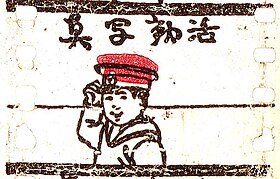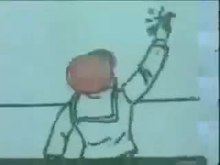Katsudō Shashin
| Anime movie | |
|---|---|
| title | Katsudō Shashin |
| Original title | 活動 写真 |
| Country of production |
|
| original language | Japanese |
| Publishing year | around 1907, at the latest in 1912 |
| length | 3 seconds |
Katsudō Shashin ( Japanese 活動 写真 , dt. "Moving pictures") is one of the oldest Japanese cartoons , so-called anime . The three second long film sequence, created with a printing technique, shows a boy writing and greeting the viewer. The author of the work is unknown and the date is controversial; it is assumed that it was composed between 1907 and 1912. Contrary to what the common name Matsumoto fragment suggests, it is a complete film, not a fragment . The original is together with the rest of the find in the collection of the finder Natsuki Matsumoto, a lecturer in art history.
description
The film consists of 50 frames, with the red and black on a 35-mm - celluloid strip in a Kappa-zuri ( 合羽版 stencil printing technique referred to) were taken. The width of the strip shrank to 33.5 mm with aging. At 16 frames per second, it's about three seconds long. Shown is a boy in a sailor suit , which the eponymous Kanji 活動写真 writes on a blackboard, turns to the audience, takes off his hat and greets him. The boy is not depicted realistically, but stylized according to a cartoon . The implementation of the print is classified as poor quality, so the color filling of the hat does not always match its outline. Sandra Annett understands the content as a self-confident and reflective presentation of a new technology, which at the same time shows the importance attached to learning to write.
Discovery, dating, origin
In December 2004, Natsuki Matsumoto, a professor of art history at the Osaka Art School and Musashino Art School and collector of old films, found out about a box of old film materials in Kyoto . In January 2005 he acquired the box that contained, along with foreign animations, projectors and video disks of older animation technology such as magic lantern , and ten other film strips, the one with Katsudō Shashin . Most of the items in the collection were intended for home use and not for public viewing, as was probably the case with this short film. By arranging the objects, Matsumoto, who examined the find together with animation film historian Nobuyuki Tsugata, was able to limit the year of origin to 1907 at the earliest, as no such collection would have been possible before. Frederick S. Litten believes the production of the film strip in 1907 and in the years before that is possible. Contemporary advertising can be used to prove that similar foreign films, especially real-life recordings, as well as the projection technology were known and available in Japan since the Russo-Japanese War 1904/1905. Litten therefore believes that it is likely that local toy manufacturers produced such short films based on the older optical toys. Not only the content with Japanese characters suggests a Japanese origin, but also the printing technique. This was traditionally used in Japan for printing on magic lanterns or silk. In addition, he quotes Matsumoto, who suspects a mass production of the short film and not a single piece. The poor quality of the print indicates a smaller company is producing. The choice of technology can be based on known German prints, or a known local printing technology was deliberately used. Both Litten and Matsumoto consider a production after 1912 to be unlikely, since the prices for celluloid rose during this period and the production of such short films would then no longer have been worthwhile.
Media reception
After discovering the film strip and its possible meaning, Matsumoto informed the Osaka edition of the Asahi Shimbun . The newspaper was the first to report on his find on July 30, 2005. The piece of film was scanned after its discovery and distributed over the Internet. In the summer of 2005 it achieved a high level of awareness and media attention. Matsumoto's statement that the film was possibly 10 years older than the oldest Japanese animated films from 1917 known up to that point in time led to great speculation in reporting and public discussion. There was some speculation about dating even before 1907, until the film was called the oldest animated film ever. However, the speculations were not based on scientific investigations of the find or even contradicted them. In the English-speaking world in particular, despite its speculative character, the year 1907 largely asserted itself for the making of the film and thus the year of making anime, not only through media reporting, but also via internet platforms such as YouTube or Wikipedia .
meaning
It is not known if the film was ever shown publicly, especially since it was likely designed as a toy for home use. Likewise, no influences on later works are known. This, along with the uncertain dating, means that the meaning of Katsudō Shashin is controversial. Frederick S. Litten sees the film as the oldest surviving Japanese animation film based on its dating. For Antonio López, the discovery of film even calls into question the pioneering role of America and France in the animation film of that time, as it may have been made before or at least at the same time as the first known animated films. He also quotes Nobuyuki Tsugata, who expressed himself in this way to Asahi Shimbun , but also pointed out that Katsudō Shashin can hardly be described as an animation film in the usual sense. In any case, according to López, the film shows that the use of 35 mm film in Japan was not due to Jun'ichi Kōuchi and Seitarō Kitayama in 1917/1918, as was previously thought. Sandra Annett counters the assessment of Katsudō Shashin as a pioneer of the animated film that, in contrast to the first French animated film Fantasmagorie from 1908 or Humorous Phases of Funny Phases from 1906 from the USA, it can not only be dated very imprecisely, but also in terms of content simply and not very creatively is held. The Japanese short film is also clearly aimed at a local audience who could read the characters, while Fantasmagorie , for example, works without writing and is internationally understandable. However, what the films have in common is a reflective approach to the medium of animation. She also questions whether a linear and teleological picture of the history of the anime with Katsudō Shashin as a starting point makes sense. In his analysis of Matsumoto's find, Litten also lists animation film strips that were produced by Ernst Plank and Georges Carette in Nuremberg together with projectors as toys for home use. A film by Carette, A good drop , was also among the short films in Matsumoto's find.
Natsuki Matsumoto himself sees the importance of the find, after the media attention has waned, not in what may be the first Japanese animated film, but in the collection as a whole. Above all, since it contains many older, simple animation techniques and optical toys such as magic lantern , it shows the much longer tradition of animation in Japanese culture. The importance of a “first” work of a certain technology takes a back seat, a continuity of cultural and technical development becomes apparent. Jonathan Clements emphasizes that zoetropes , magic lantern and praxinoscope found their way into Japan earlier and became part of stage performances in the course of the 19th century, as was the case in other parts of the world, and established themselves as toys. Animated films then also appeared for the first time in both uses.
literature
- Natsuki Matsumoto, Nobuyuki Tsugata: Kokusan saiko to kangaerareru animēshon firumu no hakken ni tsuite ( 国産 最 古 と 考 え ら れ る る ア ニ メ ー シ ョ ン フ ィ ル ム の 発 見 に に) つ . In: Japan Society of Image Arts and Sciences (Ed.): Eizōgaku ( 映像 学 ). No. 76, 2006. pp. 86-105, online (red button → text → Report to ICONOS) .
- Natsuki Matsumoto: Eiga Torai Zengo no Katei-yō Eizō Kiki: Gentō, animation, Gangu Eiga ( 映 画 渡 来 前後 の 家庭 用 映像 機器 ── 幻燈 幻燈 ・ ア ニ メ ー シ ョ ン ・ 玩具 映 画 ). In: Kenji Iwamoto: Nippon Eiga no Tanjō ( 日本 映 画 の 誕生 ). Shinwa-sha, Tokyo 2011, ISBN 978-4-86405-029-6 , pp. 95-128.
- Frederick S. Litten: Japanese color animation from approx. 1907 to 1945. 3.3 Katsudō shashin. June 17, 2014, pp. 13–15 , accessed on June 21, 2014 (English).
Web links
Individual evidence
- ↑ a b c d e Jonathan Clements : Anime - A History . Palgrave Macmillan 2013. p. 20. Reference to Matsumoto, 2011. p. 98, pp. 99-100. ISBN 978-1-84457-390-5 .
- ↑ a b c d e f Litten, 2014, pp. 11–15. This also includes a reference to Matsumoto / Tsugata, 2006, p. 92. And Matsumoto, 2011, p. 102, 108 f, 116 f.
- ↑ a b c Sandra Annett: Anime Fan Communities: Transcultural Flows and Frictions. Palgrave Macmillan, 2014. pp. 28-30. ISBN 978-1-137-47610-4 .
- ↑ a b Matsumoto / Natsuki, 2006, Online ( Memento of the original from July 22, 2015 in the Internet Archive ) Info: The archive link was inserted automatically and has not yet been checked. Please check the original and archive link according to the instructions and then remove this notice. .
- ^ A b Antonio López: A New Perspective on the First Japanese Animation . In: Published proceedings 'Confia' (International Conference on Illustration and Animation), 2012. IPCA. P. 583 f. ISBN 978-989-97567-6-2 .
- ↑ Litten, 2014, pp. 9–13.
- ↑ Clements, 2013. p. 21.

